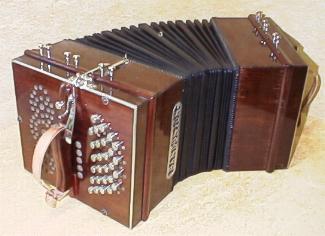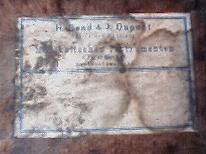Heinrich Band (1821-1860)

Heinrich Band lived at Krefeld (Rheinland/Westfalen) West Germany.
He was a music teacher, musician and publisher.
Band had his instruments made to the order, most probably at Saxony (perhaps by Zimmermann or Uhlig).
Contrary to the Konzertina he later expanded the lay-out by adding more rows of keys instead of lengthening the already existing three rows, like Zimmermann and
Uhlig were doing.
Band`s intention was to simplify the change from a small instrument lay-out to the larger instruments as players improved their musical skills.
Picture below: 100 tone Heinrich Band (1860 or older)
Reedplates zinc, reeds “German Silver”, buttons “German Silver” caps, transposed lay out G instead of standard A tuning (scale of < a > sounds as scale of < g >).
Original tuning at a1 425 Hz.

coll.H.Geuns
This instrument had already a very complete range containing all the tones of the chromatic scale.
Note the metal “mushroom” shaped register stops on top of the instrument.
A small lever next to the air valve lever, activates a special “tremolando” device giving pulsating effect to the sound by means of a complicated bellow system inside.
It is surprising to see in how short time, the bandonion has developed in such short time.
(picture below) original Heinrich Band company label, from the carrying case belonging to the bandonion shown above

Band improved the sales of musical notes by adding numbers besides, and later over the notes corresponding with the keys at the instruments.
This made the selflearning process of playing easier (most people didn`t have any knowledge of musical notes neither could they pay for a music teacher).
Also bandonion&concertina tutors were published.
This way of learning bandonion was, and still is very popular in Germany today.
The way the early bandonion/concertina range was expanded.
By Uhlig (Chemnitzer Tonlage) from 56 tones -60 -64 – 76 tones (and stays almost unchanged till 1900)
By Zimmermann (Carlsfelder Tonlage) 56- 58 – 60 – 72 – 80 – 88 – 94 – 96 – 100 – 102 and finally 104 tones.
By Band(Rheinische Tonlage) 56 – 64 – 88 (four key-rows)- 100 (five key rows)
I think that the larger lay-outs of these instruments were made in very short time, probably around 1860.
Probably the extention of the konzertina lay-outs went as fast to.